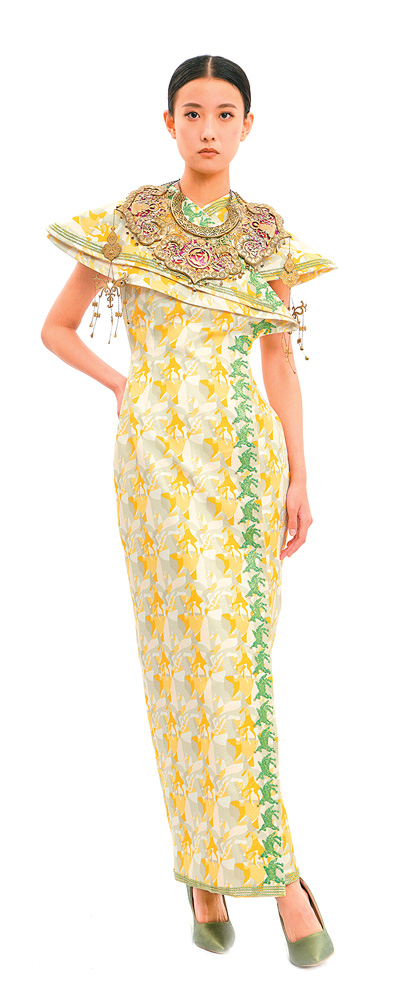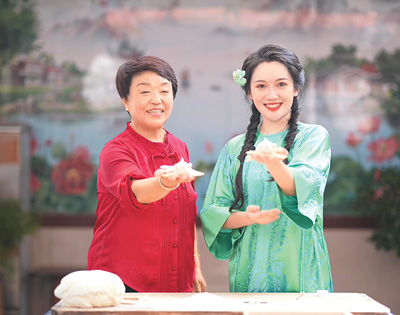costumes with traditional chinese cultural elements in vogue

photo shows a piece of brocade designed by qian xiaoping. (photo courtesy of the interviewee)
in a dazzling display of east-meets-west glamour, a launch event on innovative design inspired by silk road cultural heritage was held at france's guimet national museum of asian arts on oct. 14. the event, serving as the finale for the 2024 silk road week, showcased over 40 original outfits co-designed by chinese and french designers, blending iconic patterns of ancient silk road fashion with modern fashion.
in recent years, clothing with traditional chinese cultural elements has captured the hearts of people worldwide and made waves in international fashion circles. the fusion of intangible cultural heritage techniques with modern craftsmanship, together with creative design empowered by digital technologies, has breathed new life into china's millennia-old clothing.
traditional chinese costumes have evolved over thousands of years into a complex system in terms of materials, styles, craftsmanship, colors and patterns.
for example, song brocade, dating back to the song dynasty (960-1279), is renowned for its vibrant colors, exquisite patterns, and durable yet soft textures and is seen as a shining jewel in the crown of chinese clothing culture. early this century, the traditional weaving techniques of song brocade were listed as a national intangible cultural heritage in china and were added to the intangible cultural heritage list of the united nations educational, scientific, and cultural organization.

a model presents formal attire designed by cui rongrong's team. (photo courtesy of the interviewee)
qian xiaoping, in her 80s, is the only national-level inheritor of the song brocade legacy. the octogenarian has dedicated her life to preserving this nearly-lost craft. qian is renowned for reproducing the land of bliss, a buddhist painting weaved using song brocade techniques more than 300 years ago, according to pictures of the original work, which is housed in the palace museum.
"simply replicating artifacts for museums won't keep song brocade alive. we need to preserve traditional craftsmanship while embracing the market through modern production processes to meet consumer demands," she said.
inspired by qian's vision, wu jianhua, chairman of suzhou saintjoy silk technical culture co., ltd., pioneered the application of song brocade weaving techniques to modern production. his team achieved mass production of song brocade and optimized the design of song brocade under qian's guidance. collaborating with designers worldwide, wu's team has developed over 100 types of song brocade products, from handbags and costumes to home textiles, expanding the application of the craft.

photo shows young musician liu qingyao (r), clad in qipao, a traditional chinese dress for women, and qu lirong, an inheritor of the intangible cultural heritage of huabobo, a type of traditional steamed bun, in yantai city, east china's shandong province. (photo courtesy of the interviewee)
song brocade was used to make the traditional clothing worn by leaders at the apec meeting in beijing in 2014. since then, song brocade products of the company have frequently been presented as state gifts to foreign guests at major diplomatic events, including the g20 hangzhou summit in 2016, becoming a dazzling calling card for chinese culture.
young people are the major force of this traditional clothing revival. their enthusiasm for wearing traditional chinese attire expresses a deep love for fine traditional chinese culture. combining tradition with modern ideas has been key to attracting the youth.
to cater to contemporary aesthetic needs, qian instructs her design team to make full use of traditional cultural resources, innovatively redesign classic patterns, and infuse them with modern elements that appeal to the younger generation.
in addition, costumes with elements of other chinese intangible cultural heritages including shu brocade are also gaining popularity thanks to the inclusion of modern design concepts.
the key to traditional chinese clothing's success lies in drawing on fine traditional chinese culture while promoting creative transformation and development from an international perspective. this approach better integrates chinese traditional costumes into contemporary life and promotes them around the world.
"we need to combine chinese style with international trends to create a new fashion landscape that integrates multiple cultures and various styles, and suits multiple scenarios. by delivering fashionable products with chinese cultural elements into people's daily lives, we can better ensure cultural inheritance and dissemination," said cui rongrong, dean of the school of fashion design & engineering at zhejiang sci-tech university.
the inclusion of technology has also been a boon to the spread of chinese traditional fashion.
over the past years, the development of emerging technologies like big data and artificial intelligence (ai) has brought new opportunities to the fashion design industry. several domestic clothing companies are using ai-generated content to create creative design platforms.
-
first low-altitude helicopter tour over hangzhou's qiantang river takes flight
october 31, 2024
-
over 43,000 zhejiang buyers ready for $5 billion spending at upcoming ciie
october 30, 2024
-
hangzhou's gdp surpasses 1.5 trillion yuan in q3
october 25, 2024
-
on board g8388: lost in the qiandao lake — a unique aerial island maze
september 29, 2024

